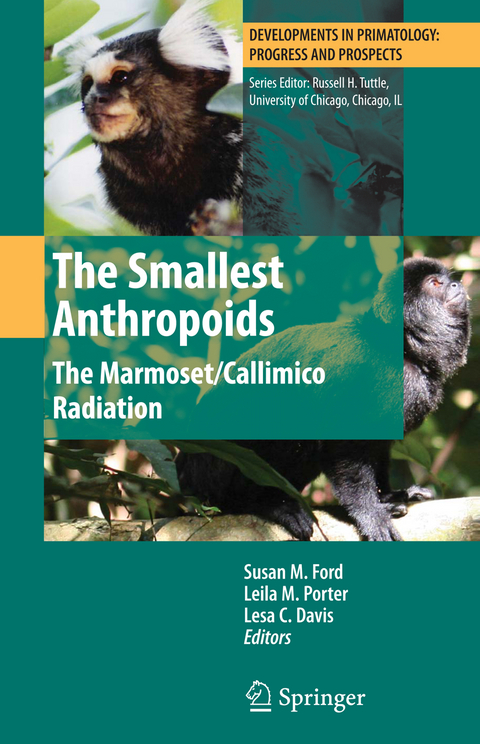The Smallest Anthropoids
Springer-Verlag New York Inc.
978-1-4419-0292-4 (ISBN)
The marmosets and callimicos are diminutive monkeys from the Amazon basin and Atlantic Coastal Forest of South America. The marmosets are the smallest anthropoid primates in the world, ranging in size from approximately 100 to 350 g (Hershkovitz 1977; Soini 1988; Ford and Davis 1992; Araujo et al. 2000); calli- cos are not much bigger, at around 350-540 g (Ford and Davis 1992; Encarnacion and Heymann 1998; Garber and Leigh 2001). Overwhelming genetic evidence, from both nuclear and mitochondrial DNA, now indicates that these taxa represent a unified clade within the callitrichid radiation of New World monkeys, a finding that was unthinkable to all but a few geneticists a decade ago (see review in Cortes- Ortiz, this volume Chap. 2). With increasing evidence that the earliest anthropoids were themselves small bodied (under the 0. 8-1 kg threshold that marks all other living anthropoids; see Ross and Kay 2004), the ecology, behavior, reproductive stresses, and anatomical adaptations of the marmosets and callimicos provide the best living models with which to assess the types of adaptations that may have characterized early anthropoids.
When Anthony Rylands' Marmosets and Tamarins: Systematics, Behaviour and Ecology was published in 1993, contributions focused almost entirely on tamarins due to the scarcity of data on marmoset behavior and the almost total lack of kno- edge about the enigmatic callimicos. Fortunately, this has changed (see Fig. 1).
Susan M. Ford is Associate Professor and Chair of the Department of Anthropology, and past Director of the Center for Systematic Biology, Southern Illinois University. Leila M. Porter is Associate Professor in the Department of Anthropology, Northern Illinois University. Lesa C. Davis is Associate Professor of the Department of Anthropology and Special Assistant to the President, Northeastern Illinois University, and Research Associate in the Field Museum of Natural History.
Phylogeny.- Molecular Phylogenetics of the Callitrichidae with an Emphasis on the Marmosets and Callimico.- The Systematics and Distributions of the Marmosets (Callithrix, Callibella, Cebuella, and Mico) and Callimico (Callimico) (Callitrichidae, Primates).- The Vocal Identity of the Callithrix Species (Primates, Callitrichidae).- Reproductive, Social, and Cognitive Behavior.- Social Behavior of Callimicos: Mating Strategies and Infant Care.- Genetic Structure Within and Among Populations of the Common Marmoset, Callithrix jacchus: Implications for Cooperative Breeding.- Mating Systems and Female–Female Competition in the Common Marmoset, Callithrix jacchus.- Balancing Cooperation and Competition in Callitrichid Primates: Examining the Relative Risk of Infanticide Across Species.- Social Hierarchy and Dispersal in Free-Ranging Buffy-Headed Marmosets (Callithrix flaviceps).- Emigration as a Reproductive Strategy of the Common Marmoset (Callithrix jacchus).- Social and Physical Cognition in Marmosets and Tamarins.- Ranging Behavior and Locomotion.- Limited Dispersal and Genetic Structure of Silvery Marmosets (Mico argentatus) in the Fragmented Landscape of Central Amazonia.- Habitat Use and Ranging Behavior of the Silvery Marmoset (Mico argentatus) at Caxiuanã National Forest (Eastern Brazilian Amazonia).- Ranging Patterns of Callimico goeldii (callimico) in a Mixed Species Group.- A Comparative Study of the Kinematics of Trunk-to-Trunk Leaping in Callimico goeldii, Callithrix jacchus, and Cebuella pygmaea.- Locomotion, Postures, and Habitat Use by Pygmy Marmosets (Cebuella pygmaea).- Anatomy.- Mother’s Little Helper? The Placenta and Its Role in Intrauterine Maternal Investment in the Common Marmoset (Callithrix jacchus).- Size and Shape in Callimico and MarmosetSkulls: Allometry and Heterochrony in the Morphological Evolution of Small Anthropoids.- Cranial Morphology of the Dwarf Marmoset Callibella in the Context of Callitrichid Variability.- The Functional Significance of Jaw-Muscle Fiber Architecture in Tree-Gouging Marmosets.- The Evolutionary Morphology of Tree Gouging in Marmosets.- Marmoset Postcrania and the Skeleton of the Dwarf Marmoset, Callibella Humilis.- Conservation.- Conservation Status of Pygmy Marmosets (Cebuella Pygmaea) in Ecuador.- Conservation of the Marmosets and Callimicos.
| Erscheint lt. Verlag | 14.9.2009 |
|---|---|
| Reihe/Serie | Developments in Primatology: Progress and Prospects |
| Zusatzinfo | 94 Illustrations, black and white; XXII, 508 p. 94 illus. |
| Verlagsort | New York, NY |
| Sprache | englisch |
| Maße | 155 x 235 mm |
| Themenwelt | Naturwissenschaften ► Biologie ► Ökologie / Naturschutz |
| Naturwissenschaften ► Biologie ► Zoologie | |
| Sozialwissenschaften ► Ethnologie | |
| ISBN-10 | 1-4419-0292-9 / 1441902929 |
| ISBN-13 | 978-1-4419-0292-4 / 9781441902924 |
| Zustand | Neuware |
| Haben Sie eine Frage zum Produkt? |
aus dem Bereich




